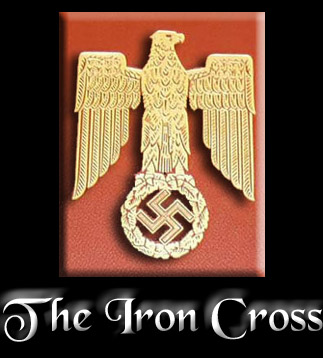
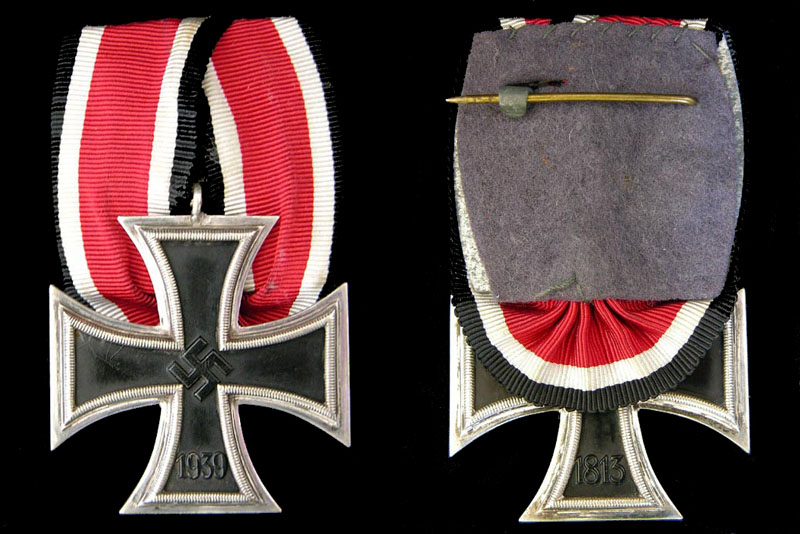
The Iron Cross is firmly established in German history. Originally conceived as an award for acts of bravery, the Iron Cross soon became a national symbol. Since 1956 it has been the emblem of the Bundeswehr.
The Iron Cross was established by King Frederick William III of Prussia in Breslau on the 10th March 1813.
The best-known German medal has its origins in the War of Liberation against Napoleon. The Iron Cross was designed by Karl Friedrich Schinkel, the Prussian architect and sculptor. The spirit of the War of Liberation is reflected in the way the medal was awarded. The Iron Cross was awarded regardless of rank to officers, non-commissioned officers and enlisted personnel. One out of every twenty combatants was awarded the Iron Cross for his commitment during the war. Some 9,000 awards were issued directly, other recipients had to wait until persons who had already been decorated died and their crosses could be awarded anew.
During the Franco-Prussian War of 1870 to 1871 the Iron Cross was reinstituted. Its design was retained, but the date of its establishment was changed on its face. Members of non-Prussian force contingents, too, were now eligible for this award.
At the beginning of World War I, the Iron Cross was re-established for the third time, by German Emperor William II on 5th August 1914. Of the approximately 13 million who fought in the war, almost one in three was awarded one of the Iron Crosses.
In addition, the Iron Cross was for the first time used in a stylized form as a German national emblem. The cloth-covered wings of Germany’s first military aircraft, for instance, were marked with the Iron Cross.
World War II
Adolf Hitler restored the Iron Cross in 1939 as a German decoration (rather than Prussian as in earlier incarnations), continuing the tradition of issuing it in various grades. The Iron Cross of the Second World War was divided into three main series of decorations with an intermediate category, the Knight's Cross of the Iron Cross, instituted between the lowest, the Iron Cross, and the highest, the Grand Cross. The Knight's Cross replaced the Prussian Pour le Mérite. Hitler did not care for the Pour le Mérite, as it was a Prussian order which could only be awarded to officers. The ribbon of the medal (2nd class and Knight's Cross) was different from the earlier Iron Crosses in that the colour red was used in addition to the traditional black and white (black and white were the colours of Prussia, while black, white and red were the colours of Germany). Hitler also created the War Merit Cross as a replacement for the non-combatant version of the Iron Cross.
Iron Cross
The Iron Cross was awarded for bravery in battle as well as other military contributions to a battlefield environment and was issued in the following two grades:
Iron Cross 2nd Class
The Iron Cross 2nd Class came with a ribbon and was worn in one of three different methods:
From the second button of the tunic. When in formal dress, the entire cross was worn mounted alone or as part of a medal bar. For everyday wear, either as a ribbon bar or the ribbon was worn from the second button of the tunic.
Iron Cross 1st Class
The Iron Cross First Class was a pin-on award and was worn centred on the left breast pocket of the tunic.
It is estimated that some 2.3 million Second Class Iron Crosses were awarded in the Second World War, and 300,000 in the First Class.
Two Iron Cross First Class recipients were women, one of those being test pilot Hanna Reitsch.
Knight's Cross of the Iron Cross
The Knight's Cross of the Iron Cross (Ritterkreuz des Eisernen Kreuzes, often simply Ritterkreuz) recognized extreme battlefield bravery or successful leadership. The Knight's Cross was divided into five grades:
Knight's Cross (Ritterkreuz des Eisernen Kreuzes)
Knight's Cross with Oak Leaves (mit Eichenlaub)
Knight's Cross with Oak Leaves and Swords (mit Eichenlaub und Schwertern)
Knight's Cross with Oak Leaves, Swords, and Diamonds (mit Eichenlaub, Schwertern und Brillianten)
Knight's Cross with Golden Oak Leaves, Swords, and Diamonds (mit Goldenem Eichenlaub, Schwertern und Brillianten)
Grand Cross of the Iron Cross
Like the Knight's Cross, the Grand Cross (Großes Kreuz) was also worn suspended from the collar. The only recipient of the Grand Cross during the Second World War was Hermann Göring, who was awarded the decoration on July 19, 1940. The medal is in effect an oversized Knight's Cross. It had the same overall characteristics as the Knights Cross but was much larger, measuring 63 mm in width as opposed to about 44 mm for the Iron Cross and 48.5 mm for the Knight's Cross. It was originally intended to have outer edges lined in gold, but this was changed to silver before the award was presented. The Grand Cross was worn with a 57 mm wide ribbon bearing the same colours as the Knight's Cross and 2nd Class ribbons. The award case was in red leather with the eagle and the swastika outlined in gold.
The Grand Cross was not a bravery award. It was reserved solely for General Staff officers for "the most outstanding strategic decisions affecting the course of the war". Hermann Göring received the Grand Cross for his command of the Luftwaffe during the successful 1940 campaign against France, Belgium, and the Netherlands (at the same time as he was promoted to Reichsmarschall of the Greater German Reich).
The original Grand Cross that was presented to Göring (personally by Adolf Hitler) was destroyed during an air raid on his Berlin home. Göring had extra copies made, one of them with a platinum frame which he was wearing at the time of his surrender to the allies in 1945. Several times in official photographs, Göring can be seen wearing his Pour le Mérite, his Knight's Cross, and Grand Cross around his neck at the same time.
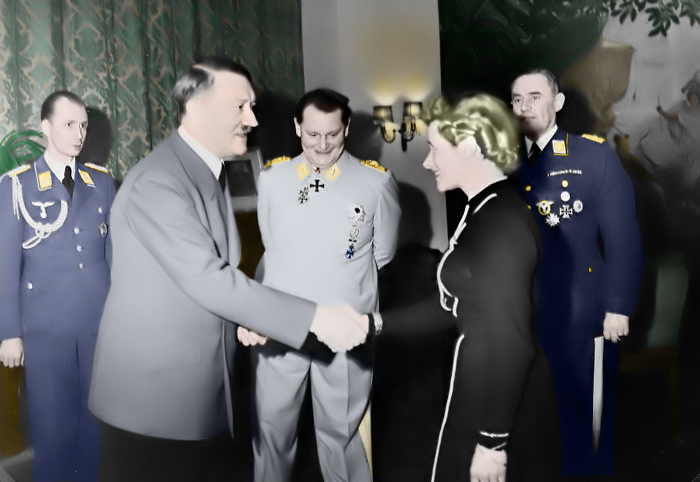
Hermann Göring seen wearing his Pour le Mérite, Knight's Cross and Grand Cross. Adolf Hitler awards the Iron Cross 2nd class to the test pilot, Hanna Reitsch
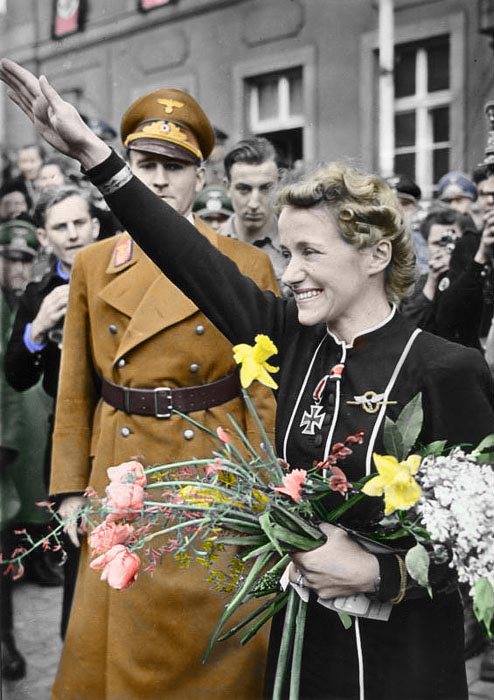
Hanna Reitsch greets the crowds after the award ceremony
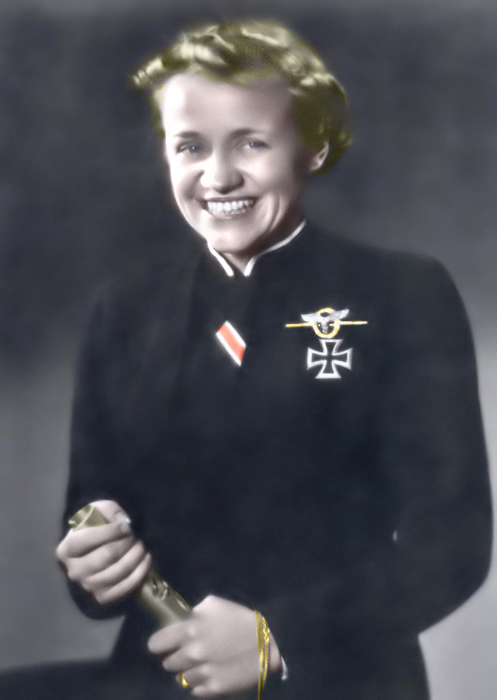
A formal portrait showing Hanna Reitsch wearing the Iron Cross 1st class and ribbon of the 2nd class
